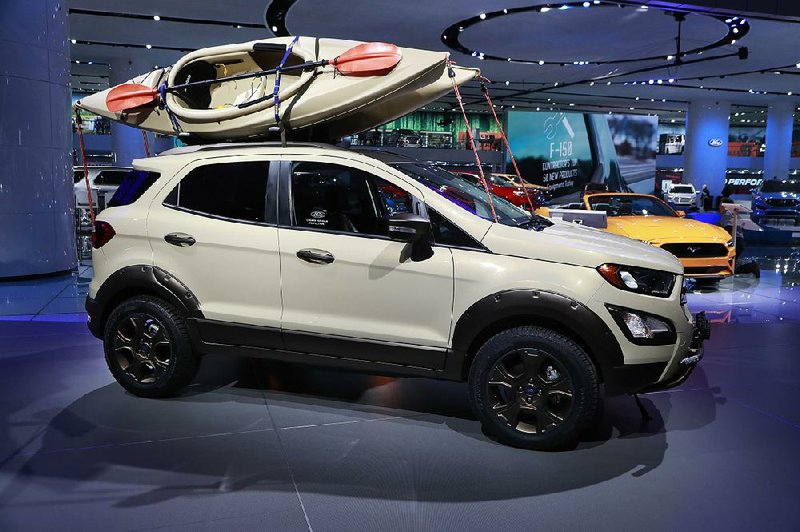DETROIT -- Automakers put out new vehicles of all shapes and sizes when the North American International Auto Show in Detroit opened to the media this week, including small cars, SUVs and the almighty pickup, which dominated the show.
All will be on display when the show opens to the public Saturday, with a charity preview Friday night.
Pickups are the most popular vehicles in the U.S., and trucks unveiled at the show make clear that will continue for a while.
General Motors spent heavily to update its top-selling Chevrolet Silverado, cutting up to 450 pounds of weight by using more aluminum and lighter high-strength steel. The truck also gets two new V8 engines that can run on one to eight cylinders depending on how much power is needed.
Fiat Chrysler's Ram also got big updates, losing more than 200 pounds and giving it a gas-electric hybrid engine option. Both the Silverado and Ram were given more athletic stances and fiercer looks. Ford added a diesel engine to its F-150 and rolled out the midsize Ranger.
Automakers turn big profits on large pickups. Sales rose nearly 6 percent last year to almost 2.4 million, even though total U.S. auto sales dropped 2 percent. Ford's F-Series is the country's top-selling vehicle, followed by the Silverado and Ram.
U.S. auto sales are likely to fall to around 16.7 million in 2018 from 17.2 million last year, says Michelle Krebs, an executive analyst with the car-buying site Autotrader.com.
But that would still make it one of the 10 best sales years in history, so the market remains strong.
Any increase in new auto sales stimulated by U.S. income tax code changes this year will likely be offset by rising interest rates and the abundant supply of late-model used cars that pull buyers from new vehicles, Toyota Motor Corp.'s top North American executive says.
North American CEO Jim Lentz expects a sales boost of 200,000 vehicles as tax cuts put more money in people's pockets. But the increase could be negated as rising rates keep some people on the sidelines, and some buyers opt for a lower-cost but nice off-lease used car.
Tax cuts could increase pickup sales because businesses can write off the expenses immediately under the new code, Lentz said.
But he expects luxury new-car sales to be flat this year even though tax rates were reduced for higher-income earners. Any decrease could be wiped out by caps on deductions for mortgage interest and local and state taxes in big luxury-car states such as New York and California, Lentz said.
Many auto executives interviewed at the auto show said they're afraid the U.S. might pull out of the 24-year-old North American Free Trade Agreement, but they can't prepare for it because they don't know what, if anything will replace it.
In ongoing negotiations with Mexico and Canada, President Donald Trump's administration is seeking to ensure that more vehicles are made in America, among other changes. But Lentz says ending the agreement would probably raise costs. That, in turn, would raise vehicle prices and cut demand, forcing manufacturing layoffs. It also would make the U.S. less competitive than the world's other manufacturing centers, he said. Ending the agreement also could force some suppliers to stop making parts.
Charlie Chesbrough, the chief economist for Cox Automotive, said it's hard to imagine there will be much change in production, because automakers need a long lead time to act and they know the next president could reverse Trump's actions. But some automakers are already taking pre-emptive steps to show the administration they're willing to boost U.S. production. Fiat Chrysler said ahead of the auto show that it will move heavy-duty truck production from Mexico to Michigan in 2020.
Automakers are hedging their bets when it comes to autonomous vehicles and whether they will someday cut into or even end personal car ownership.
In interviews through the week, executives have said they're preparing for a time when people hire self-driving ride services to get around instead of spending on personal vehicles.
But they don't know just when that will take place, so they also must continue to spend millions to develop conventional vehicles as well.
"These proclamations that we hear about the advent of electrification and artificial intelligence ... are all things that, at best, are conjecture," said Fiat Chrysler CEO Sergio Marchionne.
Although some companies plan to deploy driverless cars to carry passengers in coming months, Marchionne says it will take years for the vehicles to be in widespread use.
Mark Reuss, General Motors' head of product development, says he wishes he knew exactly when and where the switch would take place. But for now, GM and other companies have to be in both places.
"We can go either way and that agility is priceless," said Reuss.
Despite the new wheels on the show floor, one of the biggest hits is a 50-year-old Mustang GT fastback in need of a paint job. It was one of the original cars used in the 1968 film Bullitt, which put the Mustang on the map with a famous chase scene.
Ford Motor Co. rolled it out to help celebrate a special Bullitt edition Mustang, which goes on sale this summer. The faded green car got a huge cheer when it rumbled onto the stage.
Business on 01/18/2018
